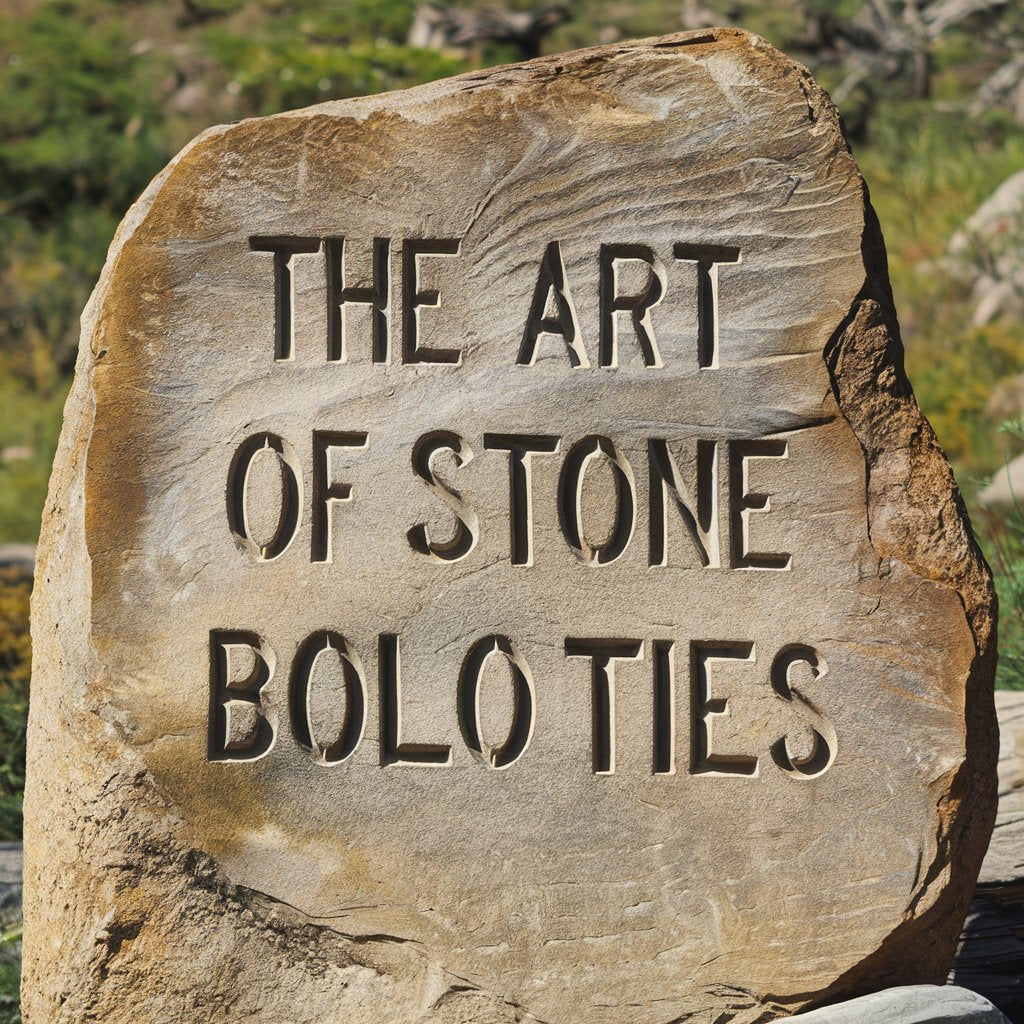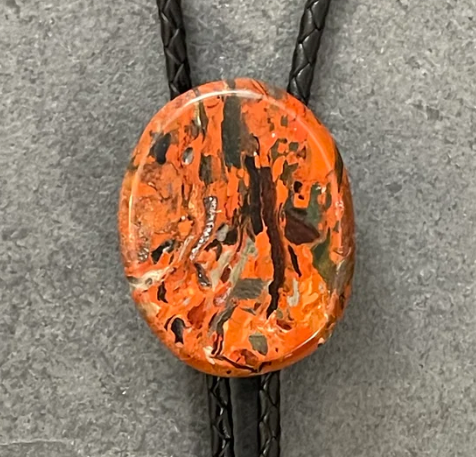Introduction
In the realm where rugged western charm meets the raw beauty of the earth, a unique fashion statement has emerged: the stone bolo tie. This distinctive accessory bridges the gap between geology and style, offering wearers a piece of natural history to adorn their necks. As a form of lapidary art neckwear, stone bolo ties have become increasingly popular among both rockhound enthusiasts and fashion-forward individuals. Let's embark on a journey through the fascinating world of stone bolo ties, exploring their historical roots, geological origins, artistic creation, and stylish applications.
A Brief History of Bolo Ties
Bolo ties, also known as bola ties, have been a staple of western wear since their invention in the 1940s. The story goes that silversmith Victor Cedarstaff created the first bolo tie when his hat blew off while riding horseback. He slipped his hatband around his neck, and the idea was born.
-
1940s: Invention of the bolo tie
-
1971: Arizona names the bolo tie its official state neckwear
-
Late 20th century: Bolo ties gain popularity in Southwestern fashion
Traditionally featuring polished stones or metalwork, these distinctive neckpieces have long been synonymous with cowboy culture and Southwestern style. The bolo tie's journey from a practical solution to a fashion statement mirrors the evolution of Western Americana itself.
The Evolution of Bolo Ties: From Classic to Crystal
While classic bolo ties remain popular, the introduction of stone bolo ties, featuring both raw and polished specimens, has breathed new life into this iconic accessory. This evolution has broadened its appeal, attracting a diverse audience of fashion enthusiasts, mineral aficionados, and those seeking unique, nature-inspired jewelry.
The shift towards stone bolo ties represents a fusion of traditional Western wear with contemporary geological fascination. These pieces serve not just as accessories, but as wearable showcases of Earth's mineral beauty.
Stone Bolo Ties: Nature's Artwork
What sets a stone bolo tie apart from its more traditional counterparts? The answer lies in its celebration of the stone's natural beauty. These bolo ties feature stones that range from completely unpolished specimens to smoothly polished cabochons, but always with minimal metalwork to let the geological wonder take center stage.
Popular Stones in Bolo Ties:
-
Agate: Known for its vibrant bands of color (e.g., "Faceted Roots – Moss Agate Bolo Tie")
-
Jasper: Offering earthy tones and patterns (e.g., "Desert Mesa – Red Lace Jasper Bolo Tie")
-
Chrysocolla and Malachite: Prized for striking blue and green hues (e.g., "Archipelago" piece)
-
Calcite: Providing a range of colors and translucency (e.g., "Seafoam Vista - Caribbean Calcite Bolo Tie")
-
Copper Ore: Displaying fascinating metallic patterns (e.g., "Michigan Mosaic" tie)
-
Montana Agate: Showcasing unique landscapes within the stone (e.g., "Prairie Shift" bolo tie)
The appeal of these stones lies in their authenticity and geological significance. Each piece, whether roughly textured or smoothly polished, tells a story millions of years in the making. The minimal settings allow the wearer to carry a piece of earth's natural history, transformed into an elegant accessory through skilled craftsmanship.
Geology Meets Artistry: The Formation of Beauty
To truly appreciate a stone bolo tie, one must understand the geological processes that created these miniature masterpieces. Each stone tells a unique story of the Earth's history, formed over millions of years through various geological processes.
Geological Origins of Popular Bolo Tie Stones:
-
Copper Ore (e.g., "Michigan Mosaic"): Formed in areas of ancient volcanic activity, where mineral-rich fluids percolated through rock fissures.
-
Caribbean Calcite (e.g., "Seafoam Vista"): Often formed in marine settings, resulting in soft, ethereal appearances.
-
Agate (e.g., "Faceted Roots" and "Prairie Shift"): Forms in cavities within volcanic rocks as mineral-rich water deposits layers of silica.
-
Jasper (e.g., "Desert Mesa" and "Crimson Canyons"): An opaque variety of chalcedony, often formed from mineral-rich volcanic ash or silt compressed and heated over time.
-
Chrysocolla and Malachite (e.g., "Archipelago"): Copper-based minerals formed in oxidized portions of copper deposits or through interactions with carbon dioxide-rich water.
Understanding these formation processes adds depth to the appreciation of each stone bolo tie. It's not just an accessory; it's a wearable piece of Earth's history, showcasing the beauty that can only be created through millions of years of geological processes.
From Earth to Neck: Crafting Stone Bolo Ties
The journey of a stone bolo tie from the earth to your neck is a testament to both natural beauty and human craftsmanship. It begins with responsible sourcing – ethical mining practices that respect both the environment and local communities.
Lapidary Techniques for Stone Bolo Ties:
-
Slicing: Creating manageable sizes from larger rough stones
-
Shaping: Ranging from minimal intervention to preserve raw textures to careful forming of smooth cabochons
-
Polishing: Bringing out inner colors and patterns of the stone
-
Drilling: Creating secure mounting points that don't detract from the stone's beauty
The stone is then combined with other elements of the bolo tie – the cord and tips. Artisans often use simple, elegant cords and tips that complement the natural stone without overshadowing it. This minimalist approach allows the geological wonder of each stone to take center stage.
Styling Your Geological Masterpiece
One of the most appealing aspects of stone bolo ties is their versatility. These unique accessories can elevate both casual and formal outfits, adding a touch of natural elegance to any ensemble.
Styling Ideas for Stone Bolo Ties:
-
Casual Look: Pair a bold stone like the "Crimson Canyons – Red Jasper Bolo Tie" with a denim shirt and boots for a modern western vibe.
-
Business Casual: The subtle beauty of the "Seafoam Vista - Caribbean Calcite Bolo Tie" can add a sophisticated touch to a crisp button-down and blazer.
-
Formal Wear: Make a statement with a striking piece like the "Archipelago – Chrysocolla Malachite Bolo Tie" against a black tie ensemble.
-
Outdoor Events: A rugged stone like the "Michigan Mosaic – Copper Ore Bolo Tie" pairs perfectly with earthy tones and natural fabrics for outdoor gatherings.
When styling, consider the colors and textures of your outfit. A vibrant jasper can add a pop of color to a neutral palette, while a more subdued calcite piece can complement a bolder outfit. The natural variations in each stone mean that your bolo tie will be a truly unique accessory, setting your look apart.
Caring for Your Stone Bolo Tie
To ensure your stone bolo tie remains a lasting piece in your collection, proper care is essential. The care requirements can vary depending on the type of stone and its finish, whether it's a raw, unpolished piece or a smooth, polished cabochon.
Care Tips for Stone Bolo Ties:
-
Storage: Keep in a cool, dry place away from direct sunlight
-
Cleaning: Gently wipe with a soft, dry cloth to maintain the stone's natural luster
-
Protection: Avoid exposure to harsh chemicals or extreme temperature changes
-
Caution: Be mindful of stone porosity – some may absorb liquids and oils more readily
Remember, the unique character of your stone bolo tie comes from its natural variations and, in some cases, its raw texture. What might appear as imperfections are often the very features that make your piece one-of-a-kind.
The Collector's Perspective: Beyond Fashion
For many enthusiasts, stone bolo ties represent more than just a fashion statement – they're miniature geological specimens, each telling a unique story of the Earth's history. Collectors often seek out rare or unusual stones, appreciating the geological significance as much as the aesthetic appeal.
Building a Stone Bolo Tie Collection:
-
Vary stone types to showcase different geological processes
-
Seek out stones from specific localities (e.g., Michigan copper ore, Montana agate)
-
Look for unique inclusions, patterns, or color variations within stones
-
Appreciate the range of finishes, from raw textures to highly polished cabochons
Collecting stone bolo ties can be an educational journey, offering insights into geology, mineralogy, and the Earth's diverse landscapes. Each piece in your collection can serve as a conversation starter, allowing you to share your knowledge of the Earth's treasures.
Ethical Considerations and Sustainability
As with any industry involving natural resources, ethical considerations are paramount in the world of stone bolo ties. Conscious consumers and responsible producers prioritize:
-
Sustainable sourcing practices that minimize environmental impact
-
Support for local artisans and small-scale miners
-
Transparency in the supply chain, from mine to finished product
The focus on showcasing the natural beauty of stones, often with minimal processing and simple settings, aligns well with principles of sustainability. This approach reduces the need for extensive manufacturing processes and allows the Earth's natural creations to shine.
Moreover, the durability and timeless appeal of stone bolo ties make them excellent candidates for slow fashion. These pieces are designed to last, becoming heirlooms that can be passed down through generations.
Conclusion: Where Earth's History Meets Personal Style
Stone bolo ties stand at a unique intersection of geology, artistry, and fashion. They offer wearers the chance to display a piece of the Earth's beauty, connect with natural history, and make a distinctive style statement.
Whether you're drawn to the raw, textured surface of a copper ore bolo tie or the smooth, polished face of a moss agate cabochon, these accessories provide a tangible link to the Earth's geological wonders. Each tie tells a story millions of years in the making, now continued through your personal style.
As you fasten your stone bolo tie, remember – you're not just wearing a piece of jewelry. You're carrying a fragment of Earth's history, shaped by time and artistry into a unique expression of natural elegance. In a world of mass-produced accessories, your stone bolo tie stands out as a true original, just like the wearer who chooses it.



Leave a comment
This site is protected by hCaptcha and the hCaptcha Privacy Policy and Terms of Service apply.